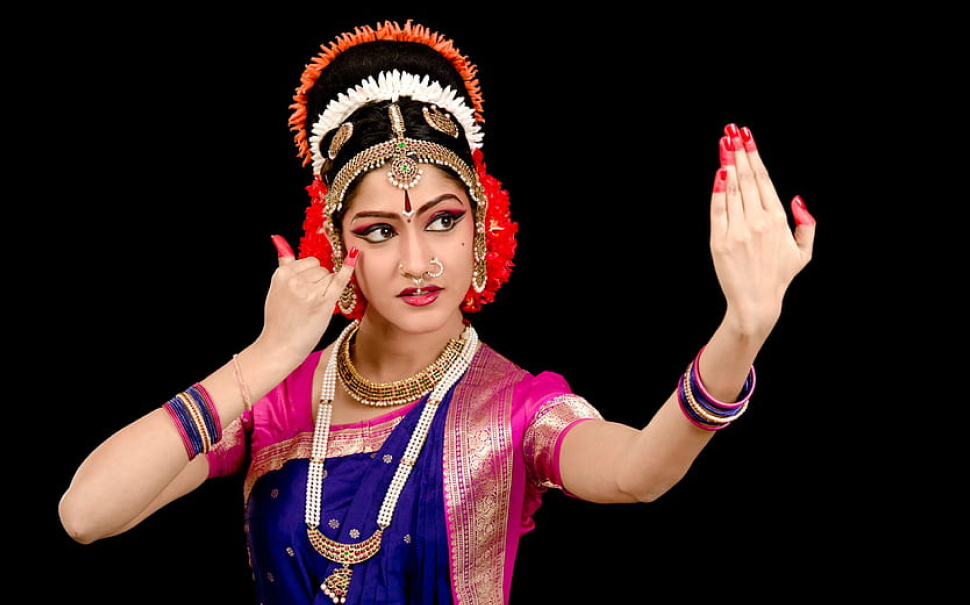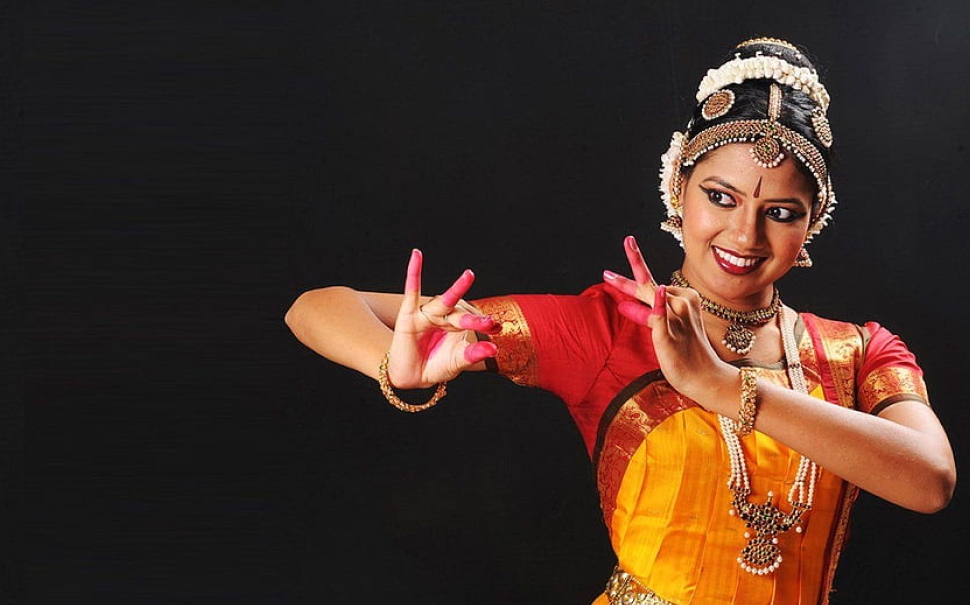Kuchipudi, the captivating classical dance form of Andhra Pradesh, India, is not just a visual spectacle but a mesmerizing tapestry woven with rhythmic melodies, vibrant costumes, and evocative narratives. Each element, from the meticulously chosen instruments to the resplendent attire, plays a crucial role in orchestrating this unique art form. This blog delves into the heart of Kuchipudi, exploring the intricacies of its musical accompaniments and the symbolism embedded in its costumes, unveiling the symphony of motion that captures hearts and imaginations.
The Rhythm that Inspires
The soul of Kuchipudi lies in its captivating music, a harmonious blend of percussion, string, and wind instruments. The Nattuvangam, played by the Nattuvanar, serves as the conductor, guiding the dancer’s movements with rhythmic syllables and footwork. This intricate art form involves the use of various syllables like “tha,” “nam,” and “dha,” each conveying specific rhythmic patterns and emotions.
The Mridangam, a barrel-shaped drum, provides the pulsating heartbeat of the performance, its complex beats mirroring the dancer’s emotions.
The Tala cymbals accentuate the rhythmic tapestry, adding clarity and definition to the musical narrative.
The Violin, a relatively recent addition, adds a layer of melodic sweetness, its smooth and evocative notes heightening the emotional depth of the performance.
The Flute, with its ethereal notes, often evokes spiritual themes and adds a touch of serenity to the performance. This harmonious confluence of instruments creates a vibrant soundscape, seamlessly complementing the dancer’s storytelling and transporting the audience to the heart of the narrative. Adding another layer of musical complexity are the vocal renditions by the accompanying vocalist.
The Sthala savarnams, the rhythmic syllables sung along with the dance, provide context and meaning to the story being portrayed.
The Padams, melodic verses sung in Telugu, express sentiments of love, devotion, and philosophical reflections, further enriching the emotional tapestry of the performance.

A Canvas of Expression: Unveiling the Symbolism of Kuchipudi Costumes
Every aspect of a Kuchipudi dancer’s attire is meticulously chosen, acting as a visual narrative in itself.
The Pachabottu, a nine-yard silk sari usually in vibrant hues, depicts various elements of nature and culture. The intricate folds and borders often feature traditional Indian motifs like paisleys and lotus buds, symbolizing fertility, abundance, and divine blessings. The Kuchipudi sari is draped in a unique style, with one pallu tucked into the right hip and the other flowing gracefully behind the dancer, creating a visually dynamic silhouette.
The Choli, a fitted blouse adorned with embroidery and sequins, adds a touch of vibrancy and accentuates the dancer’s upper body movements. The Aaharaaram, a beaded necklace, and the Vaddanam, a waist ornament, symbolize prosperity and tradition. The Hastalankara, hand ornaments like rings and bangles, not only enhance the aesthetics but also create a rhythmic interplay with the dancer’s hand movements.
The most striking component of the costume is the Mukhavarnanam, the facial makeup. This elaborate face paint, using natural colors like turmeric and sandalwood, depicts various characters and emotions portrayed in the performance. The intricate designs and symbols vary depending on the theme of the dance, serving as a visual cue for the audience to decipher the narrative unfolding on stage.
A Synergistic Symphony: Uniting Music, Movement, and Symbolism
Kuchipudi dance accompaniments and costumes are not mere embellishments; they are integral to the storytelling process. The harmonious interplay of music, movement, and symbolism creates a powerful synergy that elevates the performance beyond mere entertainment. The rhythmic beats guide the dancer’s storytelling, the melodic notes infuse the performance with emotion, and the vibrant costumes visually depict the characters and their journeys. This symbiotic relationship between the various elements makes Kuchipudi a genuinely immersive experience, intellectually and emotionally captivating the audience.
Quotes that Capture the Essence
Kuchipudi’s beauty and cultural significance resonate in its visual and sonic spectacle and the words of renowned dancers and scholars.
⦁ “Kuchipudi is not just a dance form; it’s a journey of self-discovery, a conversation with the divine through art.” – Padma Shri Dr. Sobha Naidu, Kuchipudi exponent.
⦁ “The music of Kuchipudi is the wind beneath the dancer’s wings, carrying them through the story they want to tell.” – Smt. Manju Bhargavi, Nattuvanar, and vocalist.
⦁ “The vibrant colors and intricate designs of the costumes are not just adornments; they are threads woven into the narrative, painting a visual tapestry for the audience.” – Shri Vempati Chinna Satyam, veteran Kuchipudi costume designer.

From the intricate beats of the Mridangam to the evocative notes of the Flute, from the vibrant silk of the Pachabottu to the symbolic designs of the Mukhavarnanam, every element in Kuchipudi dance accompaniments and costumes plays a vital role. This is not merely a performance; it’s a mesmerizing tapestry woven with music, movement, and symbolism, transporting audiences to a world of rich cultural heritage and captivating them with its enduring beauty.

As the final curtain falls on a Kuchipudi performance, the lingering melodies and vibrant visuals continue to resonate in the hearts and minds of the audience. This unique dance form, with its rich musical tapestry and symbolic costumes, serves as a testament to the enduring power of Indian cultural heritage, leaving a lasting impression on all who witness its captivating beauty.

